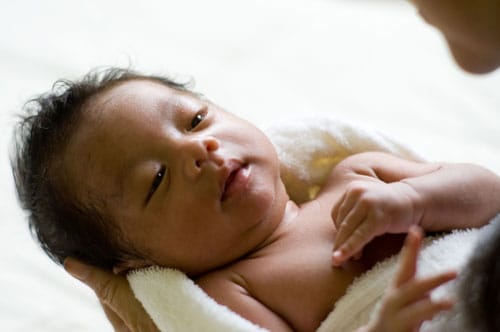Critical Congenital Heart Defects

About 1 in every 4 babies born with a heart defect has a critical congenital heart defect (critical CHD, also known as critical congenital heart disease).1 Babies with a critical CHD need surgery or other procedures in the first year of life. Learn more about critical CHDs below.
What are Critical Congenital Heart Defects (Critical CHDs)?
In the United States, about 7,200 babies born every year have critical CHDs.2 Typically, these types of heart defects lead to low levels of oxygen in a newborn and may be identified using pulse oximetry screening at least 24 hours after birth. Some specific types of critical CHDs are listed in the box to the right. Babies with a critical CHD need surgery or other procedures in the first year of life. Other heart defects can be just as severe as critical CHDs and may also require treatment soon after birth.
Double-outlet right ventricle
d-Transposition of the great arteries
Ebstein anomaly
Hypoplastic left heart syndrome
Interrupted aortic arch
Pulmonary atresia (with intact septum)
Single ventricle
Importance of Newborn Screening for Critical CHDs
Some CHDs may be diagnosed during pregnancy using a special type of ultrasound called a fetal echocardiogram, which creates pictures of the heart of the developing baby. However, some heart defects are not found during pregnancy. In these cases, heart defects may be detected at birth or as the child ages.
Some babies born with a critical CHD appear healthy at first, and they may be sent home before their heart defect is detected. These babies are at risk of having serious complications within the first few days or weeks of life, and often require emergency care. Newborn screening is a tool that can identify some of these babies so they can receive prompt care and treatment. Timely care may prevent disability or death early in life.
How Newborn Screening for Critical CHDs is Done
Newborn screening for critical CHDs involves a simple bedside test called pulse oximetry. This test estimates the amount of oxygen in a baby’s blood. Low levels of oxygen in the blood can be a sign of a critical CHD. The test is done using a machine called a pulse oximeter, with sensors placed on the baby’s skin. The test is painless and takes only a few minutes.
Pulse oximetry screening does not replace a complete history and physical examination, which sometimes can detect a critical CHD before oxygen levels in the blood become low. Pulse oximetry screening, therefore, should be used along with the physical examination.
- Problems breathing
- Pounding heart
- Weak pulse
- Very pale or blue skin color
- Poor feeding
- Very sleepy
Timing of Critical CHD Screening
Screening is done when a baby is at least 24 hours of age, or as late as possible if the baby is to be discharged from the hospital before he or she is 24 hours of age.
Pulse Oximetry Screening Results
Pulse oximetry screening is most likely to detect seven of the critical CHDs. These seven defects are hypoplastic left heart syndrome, pulmonary atresia, tetralogy of Fallot, total anomalous pulmonary venous return, transposition of the great arteries, tricuspid atresia, and truncus arteriosus. Other heart defects can be just as severe as these seven and also require treatment soon after birth. However, pulse oximetry screening may not detect these heart defects as consistently as the seven listed above.
Pass
If the baby passes the screen (also called “negative” or “in-range” result), it means that the baby’s test results did not show signs of a low level of oxygen in the blood. A baby that passes the screen is unlikely to have a critical CHD. However, not all babies with a critical CHD will have a low level of oxygen in the blood that is detected during newborn screening. Thus, it is possible for a baby who passes the screen to still have a critical CHD or other CHD.
Fail
If the baby fails the screen (also known as “positive” or “out-of-range” result), it means that the baby’s test results showed low levels of oxygen in the blood, which could be a sign of a critical CHD. This does not always mean that the baby has a critical CHD but could mean that more testing is needed. There may be other causes, such as breathing problems, for low levels of oxygen in the blood. The baby’s doctor might recommend that the baby get screened again or have more specific tests, like an echocardiogram (an ultrasound picture of the heart), to diagnose a critical CHD.
References
- Oster M, Lee K, Honein M, Colarusso T, Shin M, Correa A. Temporal trends in survival for infants with critical congenital heart defects. Pediatrics. 2013;131(5):e1502-8.
- Adapted from Reller, MD, Strickland, MJ, Riehle-Colarusso, TJ, Mahle, WT, Correa, A. Prevalence of congenital heart defects in metropolitan Atlanta, 1998-2005. J Pediatr. 2008;153:807-13.